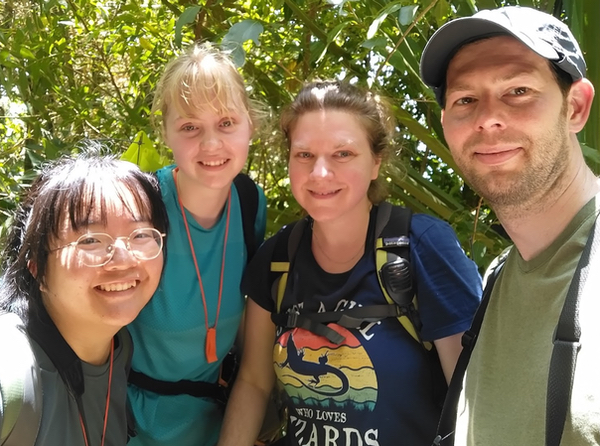Simon’s Rock Students win Torrey Botanical Society Fellowship Awards
 GREAT BARRINGTON, MA — Simon’s Rock alum Coco Deng and Senior Sophie Salisbury recently
received monetary awards for their research on the Caribbean island of Montserrat.
GREAT BARRINGTON, MA — Simon’s Rock alum Coco Deng and Senior Sophie Salisbury recently
received monetary awards for their research on the Caribbean island of Montserrat.
Working with Assistant Professor of Environmental Studies Dr. Donald McClelland, Coco Deng '20 and Sophie Salisbury '21 won prestigious Torrey Botanical Society Undergraduate Student Research Fellowships for their research projects: Deng’s “Investigation of Vertebrate Pollination of Lobelia (Campanulaceae) and Miconia (Melastomataceae) on Montserrat, West Indies,” and Salisbury’s “Comparing Lichen Growth Forms by Habitat in Montserrat, the West Indies.”
The Torrey Botanical Society Undergraduate Student Fellowship is an annual award given to three undergraduate students who are enrolled as members to the botanical society. Recipients of research fellowships are encouraged to consider publishing the results of their research in the Journal of the Torrey Botanical Society. Deng received a $1,500 award for her project, and Salisbury received the $500 award for her project.
“My research project is the first ever study on the pollination of two endemic Lesser Antillean plants - plants only native to the Lesser Antilles group of islands in the Caribbean: Lobelia cirsiifolia/digitalifolia complex and Miconia purpurea. The former is a herbaceous plant growing in a variety of wet and mesic habitats and the latter is a tree growing in high elevation rainforest,” said Deng.
Despite the rich biodiversity of Montserrat, the island’s flora and fauna remain understudied, Deng explained. The goal of her research was to identify the pollinators of these plants, which may be helpful to any future conservation efforts of these range-restricted species.
“My hypothesis was that both of these plants would be pollinated by vertebrates: hummingbirds, perching birds, and bats. Dr. Donald McClelland and Dr. Sarah Snyder were my primary mentors for this project, and alum Giulia de Gennaro, who is also Donald's former mentee, also played a major role in guiding my research,” she said. “The Torrey award and the Simon's Rock Senior Award made the field work portion of my research possible. Thanks to the Torrey award, I was able to be compensated for my research equipment and travel to Montserrat.”
Deng’s field research gear involved several cameras capable of infrared recording as well as the equipment associated with cameras and memory storage such as batteries, chargers, memory cards, card readers, tripods, power banks and more.
“So you can imagine that having sufficient funding was crucial. My faculty mentors and I are currently working on getting my thesis published, so that is the next step for me: making sure the information I have worked so hard to acquire is of use to the broader scientific community,” said Deng.
Salisbury’s research also primarily focuses on the ecology of Montserrat, specifically surveying the local lichen population to identify their growth form and uncover what their preferred habitats were.
“I applied for the Torrey Grant last winter, when I was focused on defining the methods of my research. On Montserrat, I surveyed six habitat types including dry scrub, dry thicket, dry forest, mesic forest, wet forest, and elfin forest. These habitats on the island were previously located/described by scientists using on the ground and satellite data. I was able to use a reference map when in the field in Montserrat to make sure I was surveying the correct habitat,” said Salisbury.
Salisbury describes lichens as being taxonomically within the fungi kingdom, but with more specificity as symbiotic organisms composed of a fungi, alga, and/or a cyanobacterium. Notably, they are able to grow on any undisturbed surface such as rocks, wood, soil, or bark.
“My thesis is asking whether growth form; the shape, thickness and arrangement of the various layers that make up the lichen, affects where it is best able to colonize and grow and/or is determined by the environment. My results seems to say that there is no major preference by the three groups, but I think if other traits like a photosynthesizing partner, and more specific growth forms - as there are many subcategories of lichen growth form within the three major types– that clear preferences would be discernible,” said Salisbury.
In the future, Salisbury hopes to publish some of the chapters from her thesis.
“Since I applied for the award before traveling to Montserrat, I planned and used it on some of the travel and equipment costs that I utilized in conducting the research. If I were given the opportunity I would explore this study further in order to reach clearer conclusions. Recently, I applied and was accepted into the CNS scholars program which means I will be able to use an SEM (Scanning Electron Microscope) located there for no fee. This will yield very close-up images of the layers of some of the lichens I collected that will help illustrate the differences I describe,” said Salisbury.